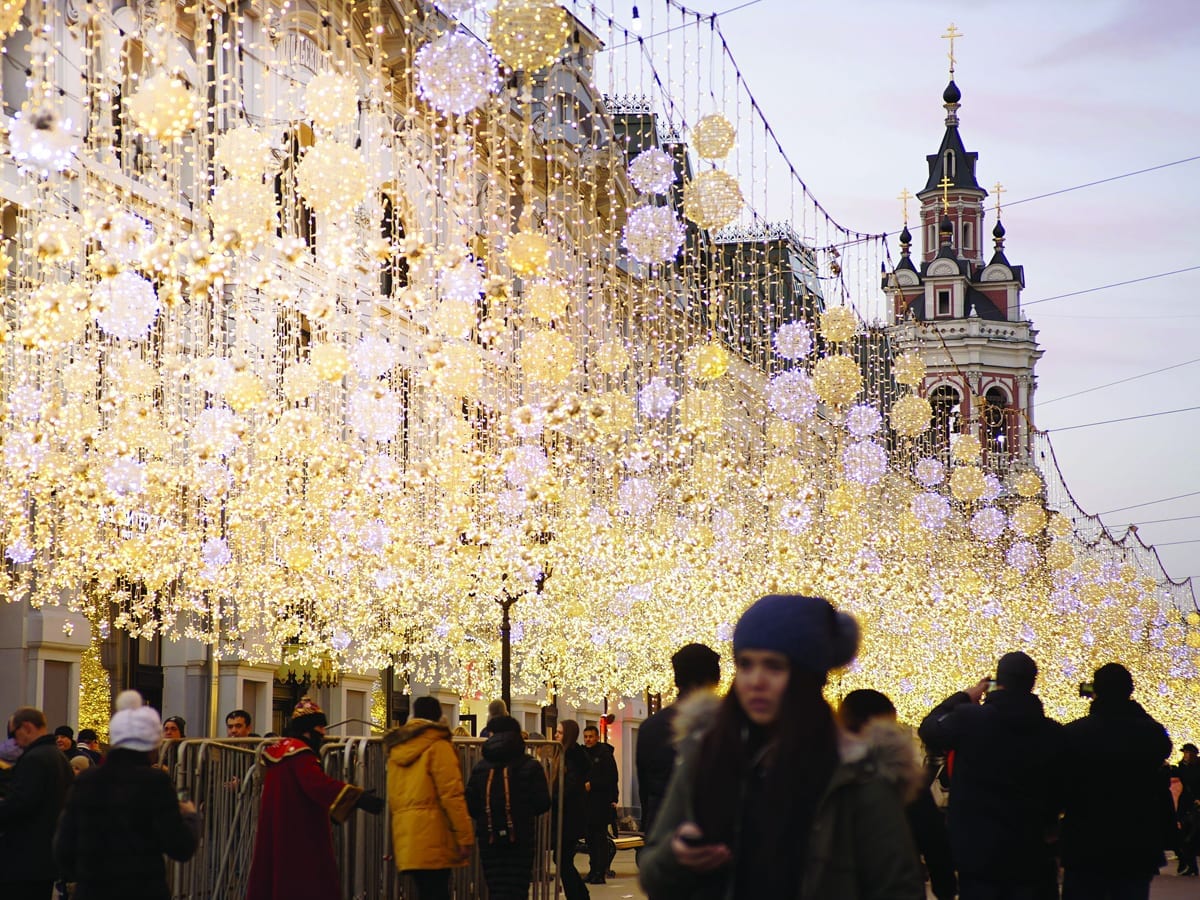The greatest ruler Russia saw was never destined to sit on the Imperial throne.
But Catherine the Great firmly believed that destiny was a thing to be harnessed. She was born Princess Sophia of Anhalt-Zerbst, a minor German backwater, and might well have become a mere footnote of history had she not caught the eye of Empress Elizabeth of Russia.
Elizabeth was the daughter of Peter the Great, the tsar whose legendary rule completely transformed Russia from an isolated, medieval, semi-Asiatic state into a powerful Western European empire and maritime superpower. After her father’s death in 1725, Elizabeth endured 11 uneasy years during the reign of her cousin, Empress Anna, when her life was in constant danger. With the help of her father’s loyal regiments, she seized power from Anna’s successor, the infant Ivan VI, in a bloodless coup in 1741 and resolved to rule Russia in the spirit of her illustrious father. The beautiful and passionate Elizabeth was energetic and exorbitant, owning more than 5,000 dresses and dazzling jewels. She loved masked balls, the thrill of the chase both of quarry and handsome men; many a noble Russian family could date its ascent in society back to a handsome member catching Elizabeth’s eye. Her most lasting affair was with a handsome Ukrainian singer, Alexei Razumovsky, who wisely stayed away from all intrigue.
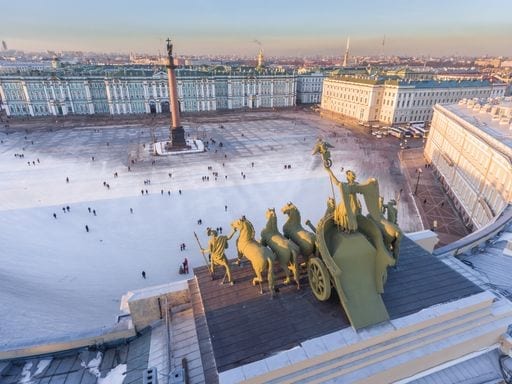
Aerial view of the Winter Palace and Aleksandr Column in Palace Square as seen through the triumphal chariot, a symbol of military glory, atop the arch of the General Staff Building. DROZDIN VLADIMIR / SHUTTERSTOCK.COM
Any discreet attempts by Elizabeth and Razumovsky to have children ended in failure. While thoroughly enjoying the present, the childless Empress kept one wary eye trained on the future; the Romanovs had been on the throne since 1613, but the succession after Peter had been choppy, with four sovereigns in 16 years.
To shore up confidence in her own reign, Elizabeth proclaimed her 14-yearold nephew, Peter Charles Ulrich, her heir. Peter arrived at court in 1742 and was almost immediately a profound disappointment to the Empress. Though he was assigned a battalion of tutors and priests to help prepare him for his future role as Russia’s autocrat, Peter proved a poor student and loathed everything about his adopted country. The only thing that remotely interested the new Grand Duke was the military, but Peter showed a marked preference for the traditions and styles of his native Holstein over those of the Russian Empire. His idol was Frederick the Great, Elizabeth’s lifelong bête noire, which did little to endear the young Grand Duke to his Imperial aunt.
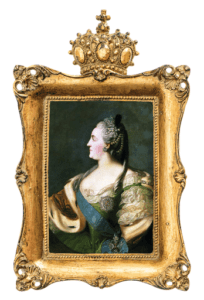
Catherine the Great, portrait painting in profile by Fyodor Rokotov, 1763.
Despite his age, Elizabeth decided Peter must marry and produce an heir as quickly as possible, a baby she could rear herself and mold into an ideal future ruler of Russia. A cursory glance at Europe’s royal studbook found Princess Sophia of Anhalt- Zerbst, and the young German princess was summoned with her mother to Russia with all haste. Elizabeth took care to ensure that Sophia, the niece of a handsome prince to whom Elizabeth had once been happily engaged, was healthy as well as good-looking. It is not clear if Elizabeth bothered to ask about Sophia’s intelligence beyond ascertaining which languages she could speak. This was less of a concern than her ability to give birth to an heir. Had Elizabeth inquired, she might have learned that Princess Sophia was unusually bright and well trained by a dedicated governess who had honed and developed Sophia’s keen mind and natural curiosity, instilling in Sophia rigorous study habits that would serve the princess well in the years to come. As Sophia made her way across Northern Europe in the dead of winter, excitement and anticipation were no doubt tempered with some anxiety. Russia was not like her native Germany, then a neat patchwork quilt of small principalities, Grand Duchies, and Landgraviates. It was only half a century since Peter the Great had dragged his medieval realm into the community of European nations, ordering his nobles to embrace European styles of dress and behavior. Russia was a Christian nation, but the alien, more mystical branch of Eastern Orthodoxy rather than Roman Catholicism or Sophia’s own Lutheran faith. Russia had weathered a 200-year occupation by the Tatar Mongols, and the civilizing influences of the Renaissance and Reformation had passed the country by. In the subsequent two centuries, there had been frequent violent uprisings, civil strife and numerous succession crises. Sophia was following in the footsteps of another Princess Sophia who had left an indelible mark on Russia, arriving in 1472 to marry Grand Prince Ivan. It was this Sophia who transformed the modest wooden Moscow “Kremlin” into an impressive complex of elegant royal palaces and magnificent stone churches topped with glittering gold domes, worthy of the Imperial legacy she brought as well as its ancient symbols and traditions: the double-headed eagle and the Imperial Roman title “Caesar,” which was translated into Russian as “Tsar.” However, the majesty and might of this Moscow Kremlin was not lost on Sophia of Anhalt-Zerbst. She was less impressed with Peter, her prospective bridegroom, confessing in her Memoirs: “…I cannot say that I either liked or disliked [Peter]…to tell the truth, I believe that the Crown of Russia attracted me more than his person.” Sophia recognized that it was Empress Elizabeth who embodied the Crown of Russia. Their relationship would never be an easy one, for Elizabeth proved a stern taskmaster. But she was also an excellent role model, and from Peter the Great’s daughter, Sophia learned many valuable lessons in statecraft. From Elizabeth, Sophia learned the importance of respecting the past and how vital it was to earn and keep the loyalty of the officers of the Imperial Guard. And though Sophia’s bridegroom, Peter found mystical rites of Eastern Orthodoxy laughable, Elizabeth herself was very devout, making elaborate pilgrimages throughout Russia to atone for her sins. To win Elizabeth’s favor, Sophia worked hard to master both vernacular Russian and to memorize the Orthodox Catechism. Soon, Sophia of Anhalt-Zerbst knelt and renounced her Lutheran faith and became the true believing Catherine Alexeievna, named for Elizabeth’s own mother, Catherine I.
The Imperial Court was centered around St. Petersburg, Russia’s new maritime capital and Peter the Great’s “Window on the West.” Catherine soon accustomed herself to the rhythms of the Imperial year. Winters were spent in St. Petersburg at the ornate Winter Palace, while in spring, the court moved to opulent Peterhof, with its magnificent Grand Cascade gushing into the Gulf of Finland. In summer, they retreated to bucolic Tsarskoye Selo and the splendid Catherine Palace, with its already-famous Amber Room and immense marble staircase. Each palace was a masterpiece of Russian Baroque, expanded from more modest versions by Elizabeth’s architect, Bartolomeo Rastrelli, in his signature style of brightly painted plaster facades, with rococo sculptures.
Married life was far from idyllic for Catherine. Peter’s behavior became more erratic and hostile, and he was unable or unwilling to consummate the marriage for many months. When Catherine showed no signs of becoming pregnant, Elizabeth placed the couple under strict supervision, threatening Catherine with annulment and exile to a convent should she not produce the desired heir. During those barren years, Catherine studied the classics and contemporary Enlightenment philosophers, including Voltaire and Diderot. While Peter publicly flaunted his mistress, Catherine, probably with Elizabeth’s tacit approval, began a passionate affair with handsome courtier, Sergei Saltykov; Catherine’s son, Grand Duke Paul, was born roughly nine months later in 1754. Elizabeth immediately whisked the infant away and showered him with all her pent-up maternal love. Saltykov was sent abroad, but soon a new love interest appeared on Catherine’s horizon: the erudite, sophisticated, and romantic Stanislaw Poniatowski, a Polish-born prince, and diplomat, by whom Catherine had at least one more child. Poniatowski understood the complexities of Europe’s politics and was instrumental in helping Catherine better understand how Russia interacted with her neighbors, At the height of Catherine’s relationship with Poniatowski, Russia was allied with Austria and France against an Anglo-Prussian alliance led by Peter’s idol, and Elizabeth’s sworn enemy, Frederick II of Prussia. As Empress Elizabeth’s health declined, Grand Duke Peter’s continued preference for Frederick II and Prussia worried many, including Catherine, who was also wary of her husband’s increasingly vocal threats to send her to a convent and marry his mistress the moment Empress Elizabeth died. With Catherine’s fate hanging in the balance, Poniatowski reluctantly left Catherine and Russia.
It was then that Catherine took decisive action and petitioned Elizabeth to be allowed to return to Germany rather than endure the humiliation of her life with Peter. It was a gamble, but Catherine was confident that “the Empress felt exactly as I did about her nephew.” She did not record the details of the conversation with Elizabeth, but she was not sent home to Germany. Elizabeth’s marked improvement in attitude towards Catherine was not lost on the Empress’s close circle, and many of the councilors pledged their allegiance to Catherine. And another critically appeared on the scene—just when he was needed most.
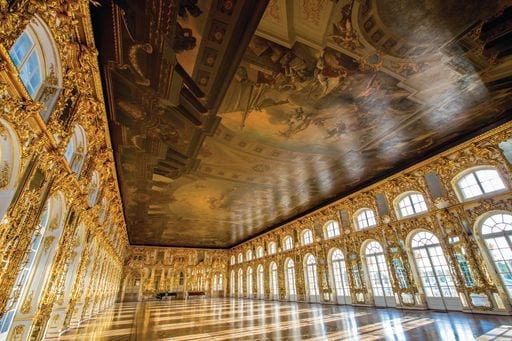
The Catherine Palace is a Rococo palace located in the town of Tsarskoye Selo, slightly south of St. Petersburg. The Great Hall or the Light Gallery is the most spacious premises in the Catherine Palace.
His name was Grigory Orlov, and he was the most handsome of five Orlov brothers, each equally as bold and reckless in the bedroom as he was on the battlefield. Orlov was no scholar and lacked the refinement and romance of either Saltykov or Poniatowski. However, he was a man of action and a popular officer in the all important Imperial Guard, as were his brothers. Catherine and Grigory soon embarked on a passionate and highly physical love affair, made more exciting by their plans to overthrow Peter. Grigory’s loyal brothers worked behind the scenes to drum up support for Catherine amongst the all-important Guards regiments. When the hour came, it was thanks to the Orlovs’ swift action and the loyal support they engendered with the regiments that Catherine was able to realize her cherished ambition. “At the bottom of my soul,” she reflected in her Memoirs, “I had something, I know not what, that never for a single moment left me doubt that sooner or later I would succeed in becoming the sovereign Empress of Russia in my own right.”
Unfortunately, Elizabeth suffered a massive stroke in December 1761 and died two days later. Catherine’s solemn and constant vigil at Elizabeth’s coffin as it lay in state in the Kazan Cathedral was in stark contrast to the newly-proclaimed Peter III’s irreverent mocking of the Orthodox funeral rites. Peter’s continued attacks on the clergy, his plans to make peace with Prussia, and his hostile behavior towards Elizabeth’s councilors convinced all three groups to pledge themselves to Catherine.
On the night of June 28, 1762, Grigory’s elder brother, Alexei “Scarface” Orlov, galloped with Catherine from Peterhof to the barracks of the Izmailovsky Regiment. Dressed in the green and red uniform of the Imperial Guard, Catherine accepted the oath of allegiance from the enthusiastic regiments and then led them on horseback to the Kazan Cathedral, where she was proclaimed Catherine II of Russia. Eight days later, Alexei Orlov confessed to killing Peter III “by accident.”
Shortly following the death of Peter III, in the Byzantine Sophia Palaiologina’s soaring Assumption Cathedral in the Moscow Kremlin, Catherine placed the dazzling new nine-pound diamond Imperial Crown on her own head. Today, the Imperial Crown holds pride of place in the Kremlin Armory’s Diamond Fund, the glittering repository of Imperial Russia’s most valuable objects, together with the golden Imperial Orb and Imperial Sceptre, adorned with the 189.62-carat “Orlov” diamond, given to the Empress by Grigory Orlov. His gift of the diamond in 1771 was a last-ditch effort to rekindle his flagging relationship with Catherine. But he had already been eclipsed by the great love of Catherine’s life, the brilliant, mercurial, and passionate Grigory Potemkin. In Potemkin, Catherine found the perfect lover, soul mate, and partner in power. She conspired to meet him whenever she could in the smaller, cozier annexes of the Winter Palace she called her “hermitages.” He was also instrumental in securing Imperial Russia’s annexation of the Crimea, which gave Russia access to the Black Sea and the integration of modern-day Belarus and Ukraine, which Catherine dubbed “New Russia.”
Potemkin was at Catherine’s side for the apogee of her reign, but in all things, she still looked to Empress Elizabeth’s illustrious father, Peter the Great, for inspiration. Catherine erected a magnificent equestrian statue, the Bronze Horseman, to Peter’s memory, which has become an iconic symbol of St. Petersburg. Catherine’s self-confessed “mania for collecting and building” formed the nucleus of the Hermitage Museum, named for the rooms in the Winter Palace she cherished as her private retreats. The graceful Neoclassical buildings so evocative of her reign remain potent symbols of the Golden Age of Imperial Russia. Catherine certainly left Russia far more beautiful than she found it, gifting St. Petersburg and the nation a superlative collection of painting and sculpture that attracts millions of tourists each year. In addition, Catherine the Great left Russia larger and far more powerful than she found it, ensuring that the throne of Russia was secure for her six successors. Each in his turn would struggle to bear the weight— and the authority it represented—of the nine-pound Imperial crown that Catherine herself had declared “as light as a feather.”
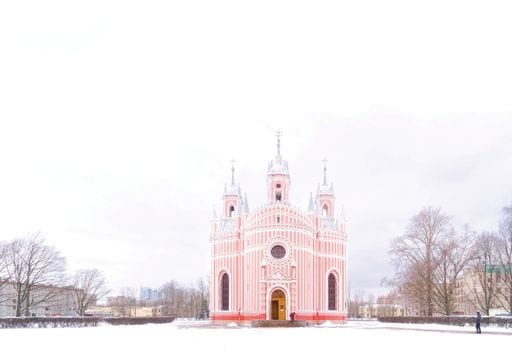
Chesme Church, or the Church of St. John the Baptist, was built under the direction of Catherine the Great. It is known as the cake church because of its pink and white color. ENCHANTED_FAIRY / SHUTTERSTOCK.COM
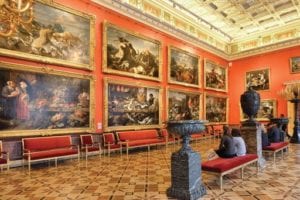
One of the oldest museums in the world, the State Hermitage was founded in 1764 by Catherine the Great upon her acquisition of a large collection of paintings. POPOVA VALERIYA / SHUTTERSTOCK.COM
Catherine’s Masters of Neoclassicism
Catherine’s new Imperial Crown was a harbinger of the Palladian and Neoclassical design in art, architecture, fashion, and urban design that was to dominate her reign. These choices were deliberate as the new Empress sought to cast Russia in the role of the successor state to the mighty empires of antiquity. Bartolomeo Rastrelli’s effervescent pastels, and plaster flourishes of the flamboyant Elizabethan Baroque were eclipsed by the more subdued yellows, symmetrical designs and understated decorative motifs favored by Catherine’s leading architects.
Catherine’s Court Architect Giacomo Quarenghi left an indelible mark on St. Petersburg, creating some of the city’s most recognizable buildings: The Smolny Institute, The Hermitage Theater, The Academy of Science and The Alexander Palace at Tsarskoye Selo, the primary residence of Russia’s last Tsar, Nicholas II. In Moscow, Quarenghi made much-needed improvements to the medieval Red Square.
Though her fingers may have itched to try, Catherine wisely did not attempt to change Rastrelli’s facade of the Catherine Palace. Instead, she commissioned Charles Cameron to create some of the Empress’s favorite corners at Tsarskoye Selo, intimate spaces where Catherine “[laid] aside all state, and [lived] with her ladies on the footing of as easy intimacy as possible.” These were the exquisite Agate Room and Cameron Gallery, decorated with busts of the Classical and Enlightenment philosophers Catherine most admired.
Antonio Rinaldi successfully made the shift from Baroque to Neoclassical with The Marble Palace on “Millionaire’s Row,” Catherine’s generous gift to Grigory Orlov “for grateful friendship” as the inscription over the main entrance reads. The Marble Palace was the first building in St. Petersburg faced with stone and the first completely built in the Neoclassical style. Today, it is a branch of the extensive Russian Museum. Russian architect Ivan Starov created the magnificent Neoclassical, single-domed Cathedral of The Holy Trinity at the Alexander Nevsky Lavra and the elegant Tauride Palace, Catherine’s extravagant gift to Grigory Potemkin, which became the template for many provincial estates throughout the empire. Later, the Taurida Palace served as the headquarters of the Provisional Government and the Petrograd Soviet in 1917.
Catherine’s Neoclassical style survived her, and for much of the nineteenth century, it dominated the significant building works in both St. Petersburg and Moscow. Carlo Rossi, famous for clean lines and perfect proportions, adorned the city with the Alexandrine Theater and National Library. He also designed Rossi Street, which bears his name, known as the world’s most perfectly proportioned street. Today, it is home to the famous Vaganova Academy of Russian Ballet. Rossi is most famous for the dynamic parabolic General Staff Building that flanks the Winter Palace on Palace Square. Joseph Bové adopted a design for the iconic Bolshoi Theater in Moscow for the company Catherine II founded in 1776.
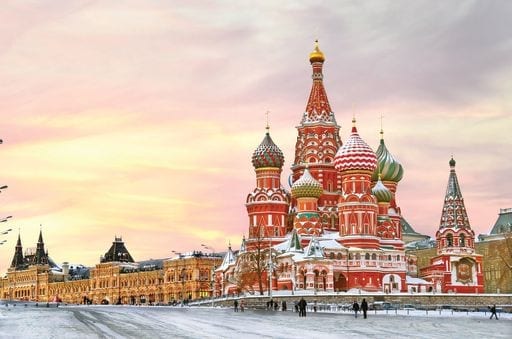
Saint Basil’s Cathedral in the Red Square is Moscow’s most famous artistic work of architecture and is considered a major symbol of the country. REIDL / SHUTTERSTOCK.COM
Travel to Russia in Winter
For those prepared to brave subzero temperatures and icy Baltic winds, winter can be the best time to experience the full range of Russia’s magnificent museums, palaces, and performing arts. The hordes of summer tourists and cruise ship passengers are gone, leaving the discerning winter traveler ample time to stroll through a half-empty Kremlin Armory Chamber, feel the majesty of Red Square, or enjoy the luxury of a leisurely exploration of the Hermitage without waiting in line. Winter affords the possibility to admire the impressive Impressionists in the Pushkin Museum of Fine Art at your own pace, linger in Rastrelli’s Amber Room as long as you wish or spend a quiet half an hour with each of Peter Carl Fabergé’s incomparable Imperial Easter Eggs at the Link of Times Museum. Opera and ballet fans will rejoice in finding the premier troops at the peak of their season and form in the legendary Bolshoi and Mariinsky Theaters. Winter is the time when Russia’s stunning architecture really comes into its own; a dusting of white snow makes the pastels of St. Petersburg and the vibrant colors and glittering onion domes of Moscow’s St. Basil’s Cathedral come alive. And where else can you discover that a bracing shot of frozen vodka from an outdoor ice bar is the perfect pick-me up after a sleigh ride in a troika or a visit to the festive Shrovetide markets?
Russia’s Surprisingly Eclectic Food Scene
Centuries of culinary history, a sprawling empire that spans multiple cultures and climates and episodic mania for importing foreign ingredients and techniques make Russian cuisine difficult to pin down. One thing remains constant, however, and that is the age-old tradition of expansive Russian hospitality, which, once experienced, is not easily forgotten.
Traditional peasant food has never gone out of fashion. Siberian pelmeni (dumplings), hearty soups, stews, and pottages such as borscht and Shchi (cabbage soup) remain as popular today as they were in Catherine the Great’s time. The cuisine of Russia’s far-flung former states such as Uzbekistan, Georgia, Armenia, and Azerbaijan have added more exotic fare such as Uzbek plov, shashlik (shish kebob) Chicken Tabaka and all manner of lamb, eggplant and pork stews.
The Russian countryside and dacha tradition offer enthusiastic amateur chefs the opportunity to ferment and preserve nature’s bounty to sustain them for the long winters. Jams, jellies, sauerkraut, and all manner of pickled vegetables are essential components of Russian cuisine and not to be missed. Imperial Russia embraced all things French, and no aristocratic home was complete without its French or Belgian chef de cuisine. From these men come a range of dishes adapted from the European canon and christened in honor of the Russian patrons: Beef Stroganoff, Veal Orloff, and Cutlets Demidov.
Today, Moscow and St. Petersburg are vibrant culinary capitals, serving up food from around the world to suit every palate. And while vodka will always retain pride of place at a groaning Russian table, Russian beer, wine, and champagne have become equally popular, as have craft cocktails.
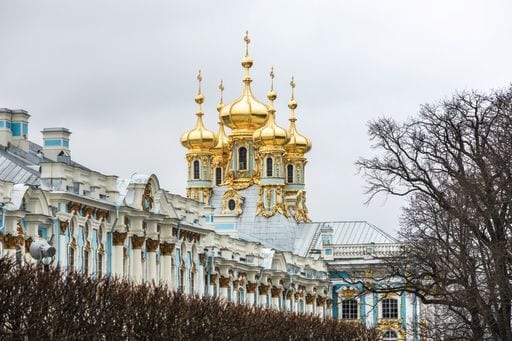
Originally built in 1717 as a summer home for Catherine the Great, the Catherine Palace is filled with ornate rooms and the white and gold royal residence is surrounded by a 1400 acre-park with fountains and bridges. ORIOLE GIN / SHUTTERSTOCK.COM
by Jennifer Eremeeva
Jennifer Eremeeva is an American expatriate writer who writes about travel, culture, cuisine and culinary history, Russian history, and Royal History. Her work has appeared in Reuters, Fodor’s, USTOA, LitHub, The Moscow Times, and Russian Life. She is the in-house travel blogger for Alexander & Roberts. Jennifer is the award-winning author of Lenin Lives Next Door: Marriage, Martinis, and Mayhem in Moscow and Have Personality Disorder, Will Rule Russia: A Pocket Guide to Russian History.

